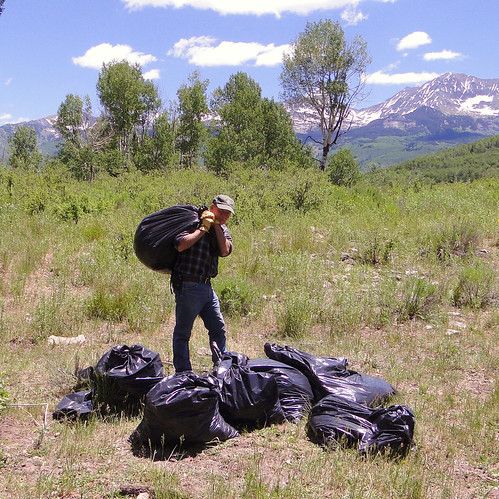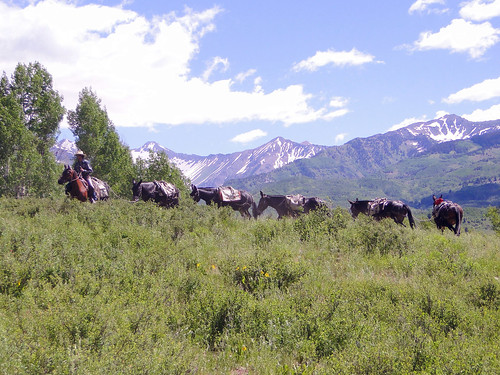
Volunteers armed with shovels and picks remove clusters of houndstongue from a high elevation meadow in the Raggeds Wilderness on the Gunnison and White River National Forests. (U.S. Forest Service/Dan Gray)
The Raggeds Wilderness, a nearly 65,000-acre area on the Gunnison and White River National Forests near Paonia, Colorado, is prime elk habitat with herd numbers in the hundreds.
Acres of undisturbed coniferous forests are interspersed with open slopes of wet meadows thick with grasses and sedges, a nutritious diet for elk needing to fatten up for the winter. But houndstongue, a purple-flowered invasive weed that takes root alongside nutritious plants, is toxic to elk.
Members of the North Fork Chapter of the Rocky Mountain Elk Foundation recently partnered with volunteers and Forest Service employees from the Grand Mesa, Uncompahgre and Gunnison National Forest to host “Whacking the Weeds,” a weed eradication and wilderness stewardship program and a way to celebrate the 50th anniversary of the Wilderness Act.
Native to Asia and Europe, this plant is known by a number of common names – beggar’s lice, dog’s tongue, sheep bur, dog bur, sheep lice, gloverwort and woolmat, all suggesting the problematic nature of its barbed seeds that stick to fur, fleece and clothing. Its foliage has the potential to cause organ failure in grazing animals like elk and cattle if eaten in sufficient quantities.
“Weed control for your own lawn is a fairly manageable activity, but in the expanses of these mountains it is much harder,” said Dan Gray, a U.S. Forest Service natural resource specialist and member of the Elk Foundation. “Certain types of weeds, like houndstongue, can be a life or death matter for various animals who feed on them. We educate our members and volunteers about the importance of weed control to provide better forage so elk may thrive in this area.”

Bags of houndstongue, an invasive species toxic to elk and other herd animals, is bagged up ready to be loaded out by packmules. Dense infestations of the weed decreases forage quality and quantity for all grazing animals. (U.S. Forest Service/Dan Gray)
A few miles into the wilderness, groups of kids, teens and adults gathered in a large meadow to chop weeds and load them into trash bags. After several hours, the Rocky Mountain Regional mule pack string arrived at the site to pack out the bundles. With fully loaded paniers, each mule hauled about 300 pounds of weeds from the wilderness.
“The pack string is always a hit with the public,” says Albert Borkowski, a Forest Service recreation specialist. “The mules are a great example of how animals were used in early Colorado history to explore and access remote, rugged areas, much of which is still protected as wilderness today.”
More areas in need of weed eradication await these eager volunteers for next year. These citizen stewards put some of the “wild” back into the Raggeds Wilderness, by ensuring more quality forage to give elk a winter survival boost.

The Rocky Mountain Region pack string are loaded with bags of houndstongue from the Raggeds Wilderness on the Gunnison and White River National Forests. (U.S. Forest Service/Dan Gray)
No comments:
Post a Comment
Note: Only a member of this blog may post a comment.